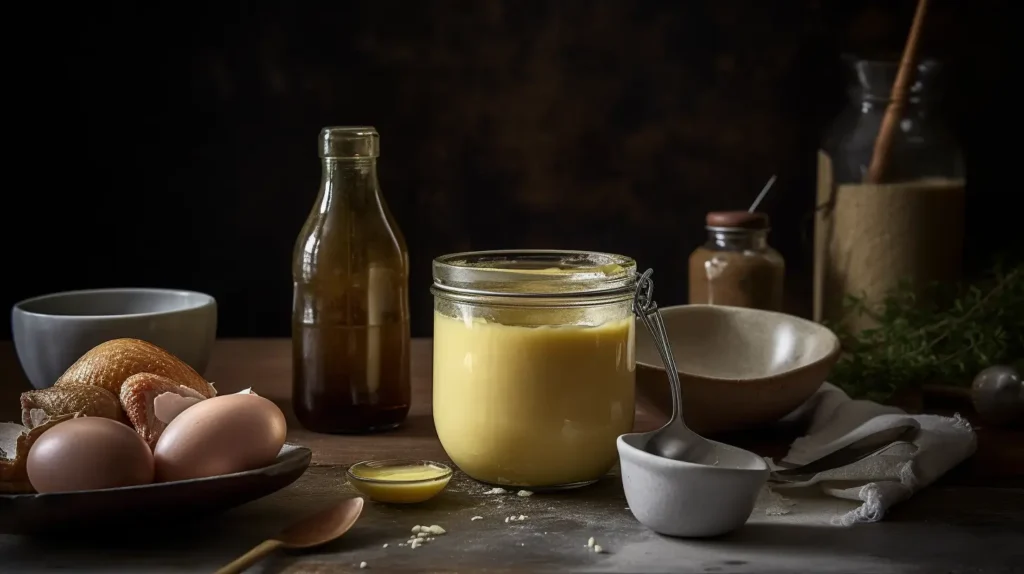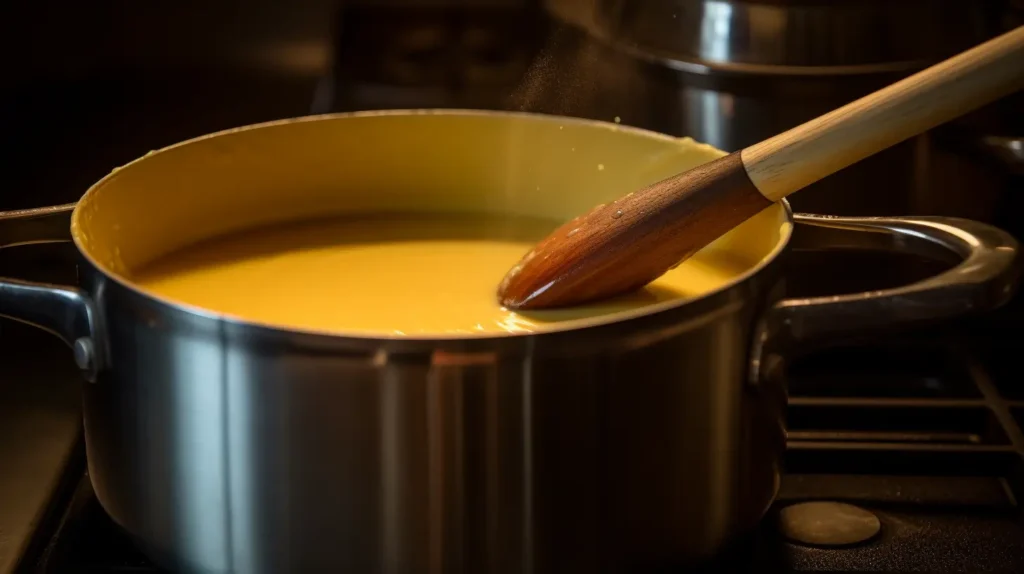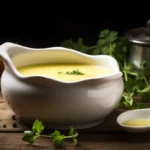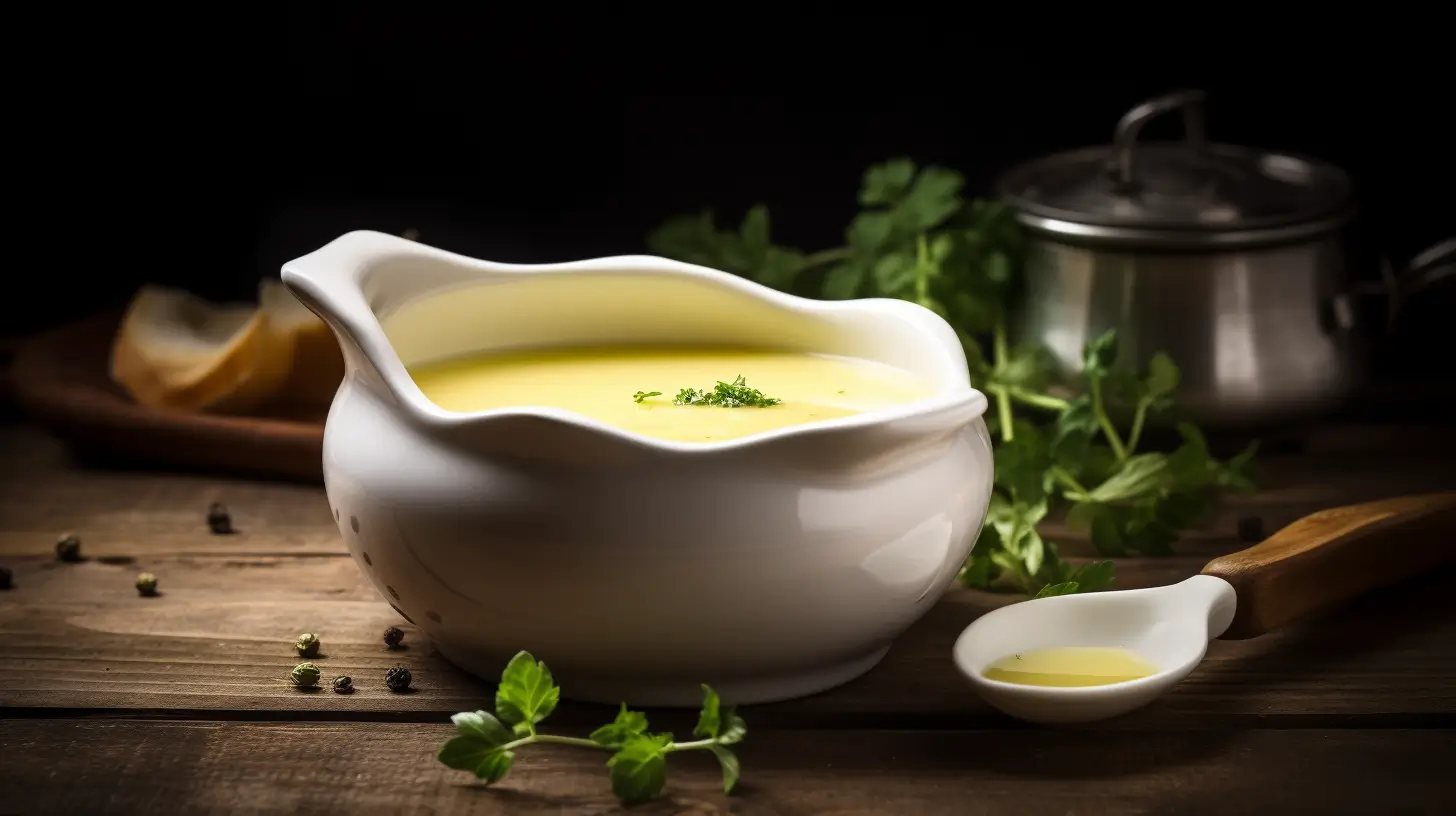Table of Contents
Introduction
If you love French cuisine, you’ve probably heard of the five mother sauces—the foundation of countless gourmet dishes. One of these is velouté, a silky, roux-based sauce that’s as versatile as it is delicious. But have you ever tried mustard velouté? This flavorful twist on the classic sauce brings a tangy depth that pairs beautifully with meats, seafood, and even roasted vegetables.
In this guide, we’ll explore everything you need to know about mustard velouté—from its origins and key ingredients to step-by-step recipes and expert tips. You’ll learn how to make it from scratch, avoid common mistakes, and even experiment with creative variations. Whether you’re a seasoned chef or a home cook, mastering this sauce will elevate your cooking game.
Let’s dive into the world of this creamy, piquant delight!
What is Mustard Velouté?
Origins of Velouté Sauce
To understand mustard velouté, we first need to talk about velouté sauce itself. This French mother sauce dates back to the 19th century, credited to chef Marie-Antoine Carême, who classified it as one of the fundamental bases of French cooking. The name “velouté” comes from the French word for “velvety,” which perfectly describes its smooth, rich texture.
Traditionally, velouté is made by thickening white stock (chicken, veal, or fish) with a roux—a cooked mixture of butter and flour. It’s then used as a base for various secondary sauces, including mustard velouté, which takes the classic formula and enhances it with the sharp, aromatic kick of mustard.
How Mustard Enhances Velouté
Adding mustard to velouté creates a unique balance of flavors. The tangy, slightly spicy notes of Dijon mustard or whole grain mustard cut through the sauce’s richness, making it more vibrant and complex. This makes it a perfect accompaniment for proteins like chicken, pork, and fish, where it adds depth without overpowering the dish.
Beyond flavor, mustard also improves the texture of velouté, lending it an even silkier consistency. The natural emulsifying properties of mustard help the sauce stay smooth and prevent separation—an added bonus for home cooks looking for a foolproof sauce!
Common Uses in French and Modern Cuisine
Wondering where to use mustard velouté? It’s an incredibly versatile sauce that enhances a variety of dishes. Here are some classic and modern ways to enjoy it:
- French cuisine: Traditionally served with poached fish, roasted poultry, or delicate veal dishes.
- Steak & pork chops: The slight acidity of mustard balances the richness of red meats.
- Seafood dishes: Perfect with grilled salmon, seared scallops, or buttery lobster.
- Vegetarian pairings: Drizzle over roasted cauliflower, asparagus, or mushrooms for a gourmet touch.
- Pasta & grains: Mix with pasta, risotto, or even quinoa for a creamy, flavorful meal.
As you can see, mustard velouté isn’t just for fine dining—it’s a sauce that can transform everyday meals into something extraordinary!
Key Ingredients for a Perfect Mustard Velouté

A great mustard velouté starts with high-quality ingredients. The beauty of this sauce lies in its simplicity—just a handful of components come together to create a rich, velvety texture with a tangy depth of flavor.
The Base: Roux and Stock
At the heart of every velouté sauce is a roux, a cooked mixture of butter and flour that thickens the sauce. For mustard velouté, you’ll want to use:
- Unsalted butter – This controls the salt content and lets the mustard shine.
- All-purpose flour – Helps create a smooth, thick sauce without lumps.
Once the roux is ready, stock is gradually whisked in to build the body of the sauce. You can use:
- Chicken stock – The most traditional and widely used option.
- Fish stock – Works well if pairing the sauce with seafood.
- Vegetable stock – Ideal for vegetarian adaptations.
Choosing the Right Mustard: Dijon vs. Whole Grain
The key ingredient in mustard velouté is, of course, mustard. But not all mustard is created equal! Your choice will affect the final flavor:
- Dijon mustard – The classic option, offering a smooth, tangy, and slightly spicy kick.
- Whole grain mustard – Adds texture and a milder, more complex depth.
- English or spicy mustard – If you prefer extra heat and boldness.
Additional Flavor Enhancers: Wine, Herbs, and Cream
To elevate your mustard velouté, consider adding:
- White wine – Adds brightness and enhances the mustard’s acidity.
- Fresh herbs – Thyme, tarragon, or parsley give the sauce an aromatic lift.
- Heavy cream – Creates a silkier, richer texture for a more luxurious finish.
By selecting the best ingredients, you set the foundation for a truly restaurant-quality mustard velouté!
Step-by-Step Recipe for Mustard Velouté

Making mustard velouté at home is easier than you think! Follow this simple step-by-step guide to create a smooth, flavorful sauce that will take your dishes to the next level.
Essential Equipment Needed
Before you begin, gather these kitchen essentials:
- Saucepan – A medium-sized pan ensures even heat distribution.
- Whisk – Essential for a lump-free sauce.
- Measuring cups & spoons – Precision is key for the perfect consistency.
Classic Mustard Velouté Recipe
Ingredients:
- 3 tbsp unsalted butter
- 3 tbsp all-purpose flour
- 2 cups chicken or fish stock
- 2 tbsp Dijon mustard (or whole grain mustard)
- ¼ cup dry white wine (optional)
- ½ cup heavy cream (optional, for a richer sauce)
- Salt and white pepper, to taste
- 1 tsp fresh thyme (optional)
Instructions:
- Make the roux – Melt the butter in a saucepan over medium heat. Once melted, whisk in the flour and cook for about 2 minutes until the mixture is pale golden and smells slightly nutty.
- Add the stock – Gradually pour in the warm stock while whisking continuously to prevent lumps.
- Simmer and thicken – Bring the mixture to a gentle simmer, stirring frequently, until it thickens (about 5–7 minutes).
- Incorporate the mustard – Stir in the Dijon or whole grain mustard, ensuring it blends smoothly into the sauce.
- Enhance the flavor – Add white wine and fresh thyme (if using), and let the sauce simmer for another 2–3 minutes.
- Finish with cream (optional) – For an extra creamy texture, stir in the heavy cream and cook for an additional 2 minutes.
- Season and serve – Add salt and white pepper to taste, then remove from heat and serve warm.
Expert Tips for a Smooth, Velvety Texture
- Don’t rush the roux – Cooking it for at least 2 minutes removes any raw flour taste.
- Use warm stock – This prevents clumps and ensures a silky consistency.
- Whisk constantly – The key to avoiding a lumpy sauce.
- Strain if needed – If your sauce isn’t perfectly smooth, pass it through a fine sieve before serving.
With this foolproof method, your mustard velouté will be restaurant-quality every time!
Best Pairings for Mustard Velouté

A well-made mustard velouté can elevate many dishes, from simple roasted meats to gourmet seafood and even vegetarian plates. Its creamy texture and tangy kick make it a fantastic sauce for various pairings. Let’s explore the best ways to serve it!
Meat Pairings: Chicken, Pork, and Seafood
- Chicken – A drizzle of mustard velouté over roasted or grilled chicken adds a French-inspired elegance. Try it with chicken breasts, thighs, or even a whole roasted bird.
- Pork chops – The tangy mustard complements the rich, slightly sweet flavor of pork. Pan-seared pork chops with a spoonful of this sauce? A match made in heaven!
- Seafood – Mustard velouté pairs beautifully with grilled or baked fish like salmon, cod, and halibut. It also enhances shellfish, especially seared scallops and lobster.
Vegetarian Options: Roasted Vegetables and Pasta
- Roasted vegetables – This sauce isn’t just for meat lovers! Try pouring it over roasted cauliflower, Brussels sprouts, or asparagus for a luxurious finish.
- Pasta dishes – Stir mustard velouté into pasta for a creamy, flavorful twist. It works especially well with tagliatelle, fettuccine, and even gnocchi.
Gourmet Combinations: Truffle, Black Garlic, and More
If you want to take your mustard velouté to the next level, try adding gourmet ingredients like:
- Truffle oil – A few drops mixed into the sauce create an earthy, luxurious depth.
- Black garlic – This fermented garlic adds a sweet-savory umami richness.
- Parmesan or Gruyère cheese – Melting cheese into the sauce gives it extra body and a deep, nutty taste.
With these pairings, your mustard velouté can transform simple meals into restaurant-quality dishes!
Mustard Velouté Variations and Twists
Looking to experiment with mustard velouté? While the classic recipe is delicious, you can easily customize it to suit different flavor profiles and dietary needs. Here are some exciting variations to try.
Creamy Mustard Velouté with White Wine
For a richer, more complex sauce, try adding white wine:
- Follow the classic recipe but deglaze the pan with ¼ cup of dry white wine before adding the stock.
- Let it simmer for a few minutes to reduce, enhancing the depth of flavor.
- Finish with a touch of heavy cream for extra silkiness.
This version is perfect for elegant seafood dishes or special occasions.
Spicy Mustard Velouté with Whole Grain Mustard
If you love bold flavors, try this spicier variation:
- Swap Dijon mustard for whole grain mustard to add a rustic texture.
- Mix in a pinch of cayenne pepper or a few drops of hot sauce for an extra kick.
- Serve it with grilled steak, pork tenderloin, or roasted potatoes for a spicy-smooth balance.
Dairy-Free or Vegan Adaptations
Want a plant-based version? No problem! Here’s how to make vegan mustard velouté:
- Replace butter with vegan butter or olive oil.
- Use vegetable stock instead of chicken or fish stock.
- Swap out cream for coconut milk or cashew cream for richness.
This variation is fantastic over grilled tofu, roasted vegetables, or pasta.
By tweaking the base recipe, you can create different flavors of mustard velouté to suit any dish or dietary preference!
Common Mistakes and Troubleshooting
Even though mustard velouté is a simple sauce, small mistakes can affect its texture and taste. The good news? Most issues are easy to fix! Let’s go over some common problems and how to solve them.
Why is My Mustard Velouté Too Thin?
If your mustard velouté is too runny, one of these reasons could be the cause:
- Not enough roux – A roux is essential for thickening. If your sauce isn’t thickening, try adding a bit more cooked flour and butter mixture.
- Too much liquid – If you’ve added too much stock, let the sauce simmer longer to reduce and concentrate its consistency.
- Not whisking enough – Constant whisking ensures that the flour and stock blend well, preventing separation.
Fixing a Broken or Grainy Sauce
Has your mustard velouté separated or turned grainy? Don’t worry! Here’s how to fix it:
- Avoid overheating the mustard – High heat can break down the mustard, making the sauce look curdled. Keep the heat on low to medium.
- Whisk continuously – A steady whisk prevents clumps and keeps the sauce smooth.
- Strain if needed – If your sauce looks lumpy, pour it through a fine-mesh sieve before serving.
How to Store and Reheat Mustard Velouté
- Refrigerate properly – Store leftover mustard velouté in an airtight container for up to 3 days.
- Reheat gently – Warm it slowly over low heat, whisking constantly to prevent separation. If it gets too thick, add a splash of warm stock to thin it out.
By following these tips, your mustard velouté will always be silky, flavorful, and restaurant-quality!
FAQs – People Also Ask
What is the difference between mustard velouté and béchamel?
Both mustard velouté and béchamel are classic French mother sauces, but they have key differences:
Béchamel is made with milk, giving it a creamy, rich texture.
Velouté is made with stock (chicken, fish, or vegetable), making it lighter and more savory.
Mustard velouté adds Dijon or whole grain mustard, creating a tangy, flavorful twist.
Can I make mustard velouté without dairy?
Yes! A dairy-free version is simple to make:
Use olive oil or vegan butter instead of regular butter for the roux.
Choose vegetable stock for a plant-based option.
Swap out cream for coconut milk or cashew cream for richness.
This version pairs wonderfully with grilled vegetables, pasta, and tofu!
How long does mustard velouté last in the fridge?
When stored in an airtight container, mustard velouté lasts up to 3 days in the refrigerator.
If you need to store it longer, freeze in small portions and reheat gently.
Can I use store-bought stock instead of homemade?
Absolutely! While homemade stock provides more depth, a high-quality store-bought stock works just as well. Look for low-sodium options to control seasoning better.
Now that you’ve mastered mustard velouté, why not experiment with different recipes? Try pairing it with roasted chicken, grilled fish, or even pasta for a delicious, gourmet meal at home!
Print
Mustard Velouté Sauce – Classic French Recipe
- Total Time: 15 minutes
- Yield: 1.5 cups (roughly 4 servings), 1x
Description
This mustard velouté is a smooth, creamy French sauce made with a roux, Dijon mustard, and stock. It’s perfect for drizzling over chicken, fish, or vegetables, adding a tangy, rich depth of flavor to any dish.
Ingredients
- 3 tbsp unsalted butter
- 3 tbsp all-purpose flour
- 2 cups chicken or fish stock (warm)
- 2 tbsp Dijon mustard (or whole grain mustard for texture)
- ¼ cup dry white wine (optional, for extra depth)
- ½ cup heavy cream (optional, for a richer sauce)
- Salt and white pepper, to taste
- 1 tsp fresh thyme (optional, for extra aroma)
Instructions
- Prepare the roux – In a medium saucepan, melt the butter over low heat. Once melted, whisk in the flour and cook for 2 minutes, stirring continuously until the mixture becomes pale golden and fragrant.
- Add the stock – Gradually whisk in the warm stock, making sure to add it slowly to prevent lumps. Increase the heat to medium and keep whisking until the sauce thickens (about 5–7 minutes).
- Incorporate mustard – Stir in the Dijon mustard and mix well. If using white wine, add it now and let the sauce simmer for 2 more minutes to enhance the flavor.
- Finish the sauce – If you prefer a creamier texture, stir in heavy cream and let it cook for another minute. Season with salt, white pepper, and thyme to taste.
- Serve warm – Remove from heat and serve immediately over chicken, seafood, vegetables, or even pasta for a gourmet touch.
Notes
- Storage: Keep leftover mustard velouté in an airtight container in the fridge for up to 3 days. Reheat gently over low heat, adding a splash of stock if needed.
- Vegan Option: Replace butter with olive oil, use vegetable stock, and swap cream for coconut milk for a dairy-free version.
- Pairings: This sauce pairs beautifully with roasted chicken, grilled fish, seared pork chops, and even roasted vegetables like cauliflower and asparagus.
- Prep Time: 5 minutes
- Cook Time: 10 minutes
- Category: Dinner
- Cuisine: French
Nutrition
- Calories: 140 kcal
- Sugar: 1g
- Fat: 12g
- Carbohydrates: 6g
- Protein: 2g
Keywords: mustard velouté, French sauce, Dijon mustard sauce, velouté recipe, creamy mustard sauce

